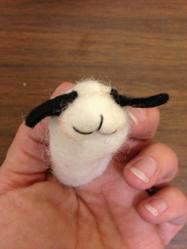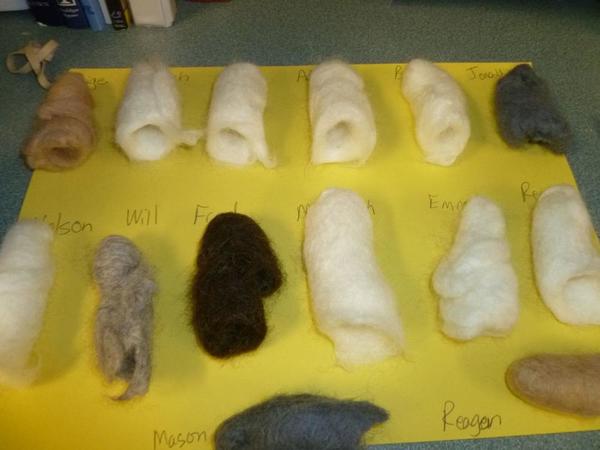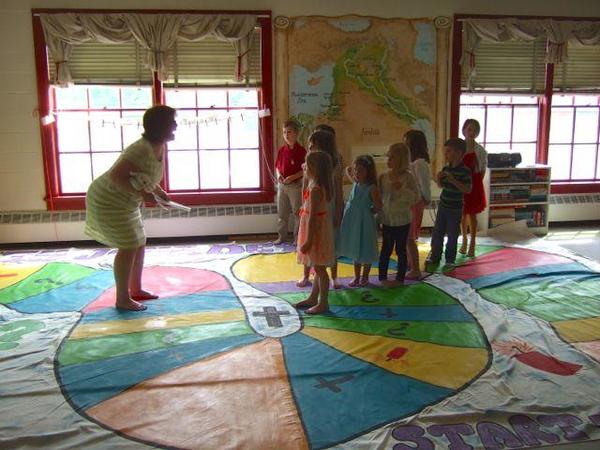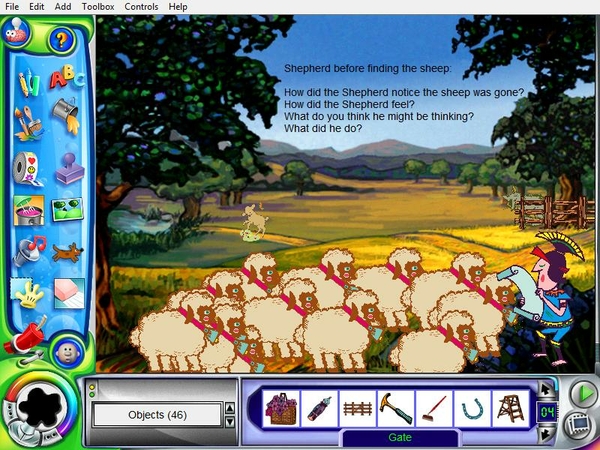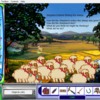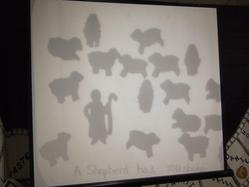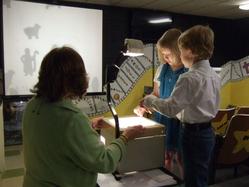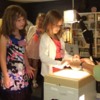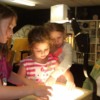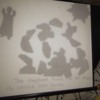Parable of the Lost Sheep
Lesson Set
Overview of the Workshops:
Bible Background below.
- Art: Children will create wet felted sheep finger puppets to use in drama sessions.
- Games/Bible Skills: Children will play a life-sized board game to review the story.
- Computers: Children will explore the story through the perspectives of the different characters using Kid's Pix.
- Drama: Children will retell the story using puppets. Children will explore modern-day situations about being “lost.”
- Movie: Children will watch several video clips that tell the story, then retell the story using an overhead projector.
Scripture References:
Luke 15:1-10, Matthew 18:10-14
Theme:
God looks for all who are lost. God rejoices and wants us to celebrate when the lost are found.
Memory Verse:
“Rejoice with me. I have found my lost sheep.” Luke 15:6b.
Rotation Objectives:
- Children will locate the story in the Bible.
- Children will identify the four gospels.
- Children will retell the story in their own words.
- Children will discuss the concept of God’s prevenient grace (grades 3-5).
- Children will identify God/Jesus as Shepherd and we as sheep.
- Children will explain what a parable is and discuss how Jesus taught using parables.
- Children will memorize Luke 15:6b.
Rotation Music CD Selections:
- “Books of the Old Testament,” Books of the Bible, Custom CD, Troy and Genie Nilsson.
- “Books of the New Testament,” Books of the Bible, Custom CD, Troy and Genie Nilsson.
- “Leaving 99.” Audio Adrenaline, Worldwide, Forefront Records, 2003.
- “One Thing Remains,” Passion: One Thing Remains, Kristian Stanfill, Sparrow Records, 2012.
- “Your Love, Oh Lord,” Third Day, Offerings, Essential Records, Brentwood Music, Inc., 2000.
- “His Love Will Go On,” RPM Volume 4, One Way Street, 1999.
- “The Steadfast Love of the Lord Never Ceases,” Acoustic Worship, Brentwood Music, 1998.
- “I am the Good Shepherd,” Verse 2 Verse, Top Kidz Scripture Songs featuring Larnelle Harris, Wonder Workshop, Inc., 2003.
- “Put a Little Love in Your Heart,” Hallelujah Hop, Brentwood Kids Company, 1994.
Background Information
The Power of Parables
Stories have tremendous power; they teach, evoke emotions and inspire thought.Stories grab the attention and kindle the imagination of the listener.The Jewish tradition was rich in stories and Jesus was a master storyteller. Jesus taught often using special stories called parables. In fact, over one third of Jesus’ teaching in the gospels is recorded in over thirty parables.
There are three divisions of parables: those that were told early in Jesus’ ministry that addressed the Kingdom of God, the later parables that told of God’s infinite mercy to those who repent and Jesus’ last parables, told shortly before his death which spoke of the reward of the righteous and eternal life.
Parables helped Jesus’ audience (and us, today) understand the world in which Jesus lived, the mind and spirit of Jesus and provided valuable lessons for living in the Kingdom of God. Jesus told parables to answer questions or to explain issues. A parable uses everyday images to illustrate something about God or God’s kingdom or a particular spiritual truth. Parables are sometimes referred to as “earthly stories with heavenly meanings.” Jesus used everyday objects and common situations in the parables he told. The use of the common or well-known image helped the listeners understand the less well-known concept. The images that were familiar to first century Palestine might not be as familiar to us today. What images might Jesus use today to convey the same truths?
The word parable comes from a Greek word that “means, literally, ‘that which is tossed alongside.’ This implies a comparison, analogy, elaboration, or illustration. Parables invite the audience to come alongside and be part of the story. They invite audience participation. Parables do not tell you what to think, they require the listener to reflect and examine the story and its meaning. Parables allow the hearers to understand the message on different levels to accommodate their different abilities and willingness to accept the message. Jesus often said that the unwilling and those without faith would not understand the deeper meanings of the parables he told. To these people, a parable was simply a story. But for those who listened with willing, open hearts and faith, the message could be life transforming! This is true for us today as well!
Many of Jesus’ parables were told as a result of confrontation with the Pharisees. The Pharisees regularly criticized Jesus for his association with tax collectors and other “sinners.” According to the Pharisees, respectable religious people didn’t associate with people who disobeyed God’s laws. Jesus often attacked this legalism – accusing the Pharisees of caring more for their rules and “outward show” than truly loving people and helping them.
The Parable of the Lost Sheep
The Parable of the Lost Sheep is the first in a series of three parables about the Lost: the lost sheep, the lost coin and the lost son (or Prodigal Son). Jesus (as he so often did), used these parables to make a point to the critical Pharisees. Pharisees were self-righteous religious leaders who believed the expected Messiah would arrive and establish a powerful and glorious kingdom in which they would have ruling positions. It was beyond their radar screen to see the Messiah as a heavenly Shepherd, rather than an earthly King. The Pharisees publicly criticized Jesus for eating with tax collectors and sinners. Tax collectors were despised because they were fellow Jews hired by the Romans to collect Romans taxes. Most tax collectors cheated by collecting more than was owed and pocketing the difference. “Sinners” were the obvious criminals and prostitutes, but also those who did not live up to the Pharisees’ meticulous and multiple regulations of religious living. For most working men, it was impossible to keep all of the rules and regulations set by the Pharisees, therefore many were considered ceremonially unclean and shunned by the religious leaders. Pharisees placed little value on the lives of these so-called sinners believing that their behavior made them beyond saving. Jesus told the three parables of the lost to confront their hypocritical and self-righteous attitudes. By demonstrating his care and concern for the lost, Jesus showed the Pharisees what their attitude should be. This should be our attitude as well.
Seeking the Lost.
Jesus clearly was not thinking of himself. If he had been thinking of his own comfort, he would no doubt have spent his time with angels and holy and faithful people. But Jesus’ heart was set upon the lost, and therefore he sought them out. Jesus spent his life pursuing lost souls. Jesus clearly knew his purpose was to “seek and save the lost.” (Luke 19:10) Jesus believed that God’s message of saving grace and love was for all who believe – not just for those who followed the rules of the Pharisees. He believed that spending time with the “lost” was a way to show them God’s love and bring them God’s message of salvation. The Pharisees, of course, would never do such a thing. They lacked tenderness and compassion. They were concerned with self, alone. They might have been religious, but they were not godly. To be godly means to be willing to give of oneself to others as Christ did.
Jesus chided the Pharisees by asking them, “Which one of you with one hundred sheep, would not pursue the one lost sheep? Or a lost coin?” How much more valuable is a person than a sheep or a coin! To God, every life is of infinite value! God doesn’t desire that any should perish, but that all should come to repentance. (2 Peter 3:9)
Finding!
How does the Shepherd respond to the lost sheep once it is found? Does he chastise it or punish it for its waywardness? No! Rather we see a picture of loving care, compassion and mercy. The shepherd gently lifts the sheep onto his shoulders and carries it back to the fold. What a wonderful picture of God’s great and tender mercy for us when we, like sheep have gone astray.
Rejoicing!
Jesus tells us that there is great “joy in heaven” over even one sinner who repents and returns to the fold. Once the shepherd and the lost sheep have returned we read that there is great rejoicing! In fact the shepherd calls his friends and neighbors asking them to rejoice with him! Is there criticism from the 99 sheep that were left alone? Do they begrudge the time the shepherd spent away, searching for their wayward sibling? Later in the parable of the Prodigal Son, we read that this is exactly the attitude of the Pharisees toward God’s mercy and grace. How can God lavish such attention on sinners? What about them? Aren’t they the “good ones,” “the religious ones,” the ones who follow the rules? We can practically hear their whines…. “It’s not fair….”
It’s all about grace.
Grace is the gift of God’s mercy and love. There is nothing we can do to earn this. It is a gift, freely given. All we need to do is accept it. The Pharisees missed the main point here. They believed they could earn their way to heaven by their good works and their attention to “religious rules.” Unfortunately, their actions simply led to the development of self-righteous attitudes that placed them deeper in sin. From this perspective we see that the Pharisees were just as “lost” as those they criticized! The only difference between the Pharisees and the “lost” is that the “lost” knew they needed a Savior!
John Wesley described God’s saving grace in three forms: prevenient, justifying and sanctifying. Prevenient grace is God’s grace given to us even before we understand about God. This is God actively pursuing us and wooing us throughout our life. God is calling us to Him. Justifying grace is that moment when we accept Jesus as our Savior and receive God’s promised gift of eternal life. We are made right with God because of Jesus’ actions on the cross on our part. Sanctifying grace is the work of the Holy Spirit within us as we grow more and more like Christ.
Who are the sheep?
Shepherds and sheep were common images in Jesus’ time. Sheep are affectionate, non-aggressive, not very intelligent animals in need of constant supervision and care. Scripture commonly uses the shepherd metaphor to refer to God/Jesus and the sheep metaphor to us.
What does it mean to be lost?
We are lost when we are separated from God. This can be the result of rebellion, or simply from inattention.
What are ways we get lost? Do we just simply not pay attention and wander away? Do we take our eyes off the Shepherd for just a moment or two, only to find we have lost our way? Or do we intentionally or sub-consciously sneak away?
How does it feel to be lost? Is it scary or lonely?
Do we sometimes want to get lost? What are the advantages of being lost?
Can we ever really get lost from God?
How does it feel to know that no matter how far away we wander, God will come after us?
Some key points.
- People are precious to God!
- God seeks out all who are lost.
- Saving even one is cause for rejoicing!
- No matter how far we may wander, God never stops looking for us and wanting us to return home!
- God calls us to celebrate with him when the lost are found.
- Seeking the lost may mean that we have to go into the wilderness at times.
- Seeking the lost may mean we have to put up with those who “murmur” against us.
- God doesn’t give up on anyone, so we shouldn’t either.
Discussion questions:
- What happened in this story?
- Why would the shepherd leave 99 of his sheep to look for just one sheep? (because he loved ALL his sheep – every single one was important to him!)
- Have you ever lost anything? How did that feel? What did you do?
- I wonder how the shepherd felt when he realized one sheep was missing….
- I wonder why the sheep got lost….
- I wonder what it means to be “lost?” (for older children, explore the different levels of meaning – being separated from God, rebelling from God, taking our eyes off the shepherd – Jesus, etc.)
- What is grace? (God’s free gift of mercy and love to us, nothing we can do to earn it, just accept it)
- What is a parable? (a story using everyday objects to explain important truths – an earthly story with a heavenly meaning)
- Why might Jesus have taught using parables?
- How did the Pharisees respond to Jesus? (they were angry and jealous, they were full of pride and self-righteous about how well they followed the rules, they thought Jesus shouldn’t spend time with “sinners” and tax collectors)
- Why did Jesus disagree with the Pharisees? (he knew everyone was important to God, especially the “lost,” he came to save the lost)
- When is a time you have felt especially lost or separated from God? What happened?
- How does it feel to know that God will never stop “looking for you?”
- What happened once the lost sheep was found? (the Shepherd rejoiced, he called all his friends and neighbors to rejoice with him)
- I wonder what it must be like for God and all the angels to rejoice…
- Did the Shepherd punish the sheep when he found it?
What images might Jesus use today to convey the same truths?
These parables tell us something very important about how God feels about us. What do you think that is? (That we are valuable to God, just like the coin and sheep were valuable to the people in the stories.)
Did you know the Bible talks many times about Jesus being a shepherd and about us being the sheep. What will happen if one of us feels lost or separated from God? (Jesus will find us. He may send someone like a friend or parent or minister, but it will be because Jesus is looking for us.)
Sources:
Bible Teacher’s Commentary, Lawrence O. Richards, Cook Communications, 2002.
New Invitation Bible Studies, Graded Press, 1994-95, 1989.
Richard’s Complete Bible Dictionary, Lawrence O. Richards, World Bible Publishers, 2002.
“The Lost Sheep, the lost Coin and the Lost Son” www.gracethrufaith.com.
“The Parable of the Lost Sheep” a Sermon by C. H. Spurgeon, September 28, 1884, www.spurgeon.org.
“The Parable of the Lost Sheep” by David Coote, International Bible College, “The Lost Sheep” www.orthodoxphotos.com.
“The Parables of Jesus” www.ccel.org;
Faith Quest Bible Study http://www.kirkofkildaire.org/...eadersBibleStudy.htm.

